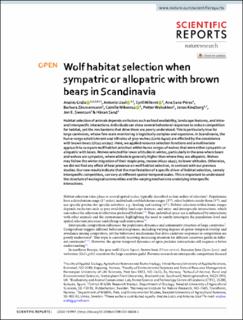Wolf habitat selection when sympatric or allopatric with brown bears in Scandinavia
Ordiz Fernandez, Andres Avelino; Uzal, Antonio; Milleret, Cyril Pierre; Sanz-Perez, Ana; Zimmermann, Barbara; Wikenros, Camilla; Wabakken, Petter; Kindberg, Jonas; Swenson, Jon; Sand, Håkan
Peer reviewed, Journal article
Published version
Permanent lenke
https://hdl.handle.net/11250/3018440Utgivelsesdato
2020Metadata
Vis full innførselSamlinger
Originalversjon
10.1038/s41598-020-66626-1Sammendrag
Habitat selection of animals depends on factors such as food availability, landscape features, and intraand interspecific interactions. Individuals can show several behavioral responses to reduce competition for habitat, yet the mechanisms that drive them are poorly understood. This is particularly true for large carnivores, whose fine-scale monitoring is logistically complex and expensive. In Scandinavia, the home-range establishment and kill rates of gray wolves (Canis lupus) are affected by the coexistence with brown bears (Ursus arctos). Here, we applied resource selection functions and a multivariate approach to compare wolf habitat selection within home ranges of wolves that were either sympatric or allopatric with bears. Wolves selected for lower altitudes in winter, particularly in the area where bears and wolves are sympatric, where altitude is generally higher than where they are allopatric. Wolves may follow the winter migration of their staple prey, moose (Alces alces), to lower altitudes. Otherwise, we did not find any effect of bear presence on wolf habitat selection, in contrast with our previous studies. Our new results indicate that the manifestation of a specific driver of habitat selection, namely interspecific competition, can vary at different spatial-temporal scales. This is important to understand the structure of ecological communities and the varying mechanisms underlying interspecific interactions.

